The cabinets of curiosity featured in the last episode of this series often featured a section containing a mixed collection of stones, minerals, and fossils all thrown together in one category of natural history. This is not surprising when one thinks that the word fossil originally meant anything dug up out of the ground, from the Latin fossilis meaning dug up, and only acquired its modern meaning at the beginning of the eighteenth century. This is wonderfully illustrated by the fact that the first published description of a pencil is in Conrad Gessner De Omni Rervm Fossilivm Genere (1565), graphite being something that is dug up.
Whilst not necessarily to the extent that modern botany was formed by the Renaissance, the three disciplines of palaeontology, mineralogy, and geology also began to gradually emerge during the Renaissance.
As with the other areas of natural history the Renaissance interest in things out of the earth begins with the recently published books from antiquity. Aristotle (384–322 BCE) wrote about the properties of minerals in terms of his general four element theory of all known substances. Theophrastus (370–285 BCE), Aristotle’s pupil and successor as head of the Peripatetic school, followed Aristotle in dividing minerals into two categories–those affected by heat and those affected by dampness–in his De Mineralibus. Theophrastus’ knowledge of a wide range of substances was quite extensive. He knew that both amber and magnetite had powers of attraction, that pearls came from shellfish, and that coral comes from India. He also knew about coal and the metal ores, and that pumice stone is volcanic in origin. He knew about the practical use of various minerals in production of glass, pigments, and plaster. He also describes precious stones. He is aware that minerals often come from mines and discusses gold, silver, and copper mines. He apparently also wrote a separate work On Mining, which is lost.
As is almost always the case, Theophrastus’ wide-ranging work on minerals is overshadowed by the much more extensive writings of Pliny (23/24–79 CE) in his Naturalis Historia in which books 33 to 37 in volumes IX and X are devoted to mining and mineralogy, especially as applied to life and art, work in gold and silver, statuary in bronze, art, modelling, sculpture in marble, precious stones, and gems. He describes many more minerals than Theophrastus, discussing their properties and applications. He was the first to recognise the correct origin of amber.
The other driving force, during the Renaissance, behind the increased interest in things out of the earth was the development of a major mining industry in Middle Europe for the extraction of metal ores. These developments are reflected in the publications of two significant and successful books on the practice of mining, the Pirotechnica of the Italian mining engineer, Vannoccio Biringuccio (1480–1539), published posthumously in 1540 and De re metallica by the German physician Georgius Agricola (1494–155), also published posthumously in 1556.
Book I of Biringuccio’s Pirotechnica is titled Every Kind of Mineral in General and deals with the location of metal ores and deals separately with the ores of gold, silver, copper, lead, tin, and iron. Book II continues the theme with what Biringuccio calls the semi-minerals an extensive conglomeration of all sorts of things that we wouldn’t necessarily call minerals. Starting with quicksilver he moves on to sulphur then antimony, marcasite (which includes all the sulphide minerals with a metallic lustre), vitriol, rock alum, arsenic, orpiment, and realgar. This is followed by common salt obtained from mine or water and various other salts in general then calamine Zaffre and manganese. As with Theophrastus he also, under minerals, deals with loadstone, Theophrastus’ magnetite.
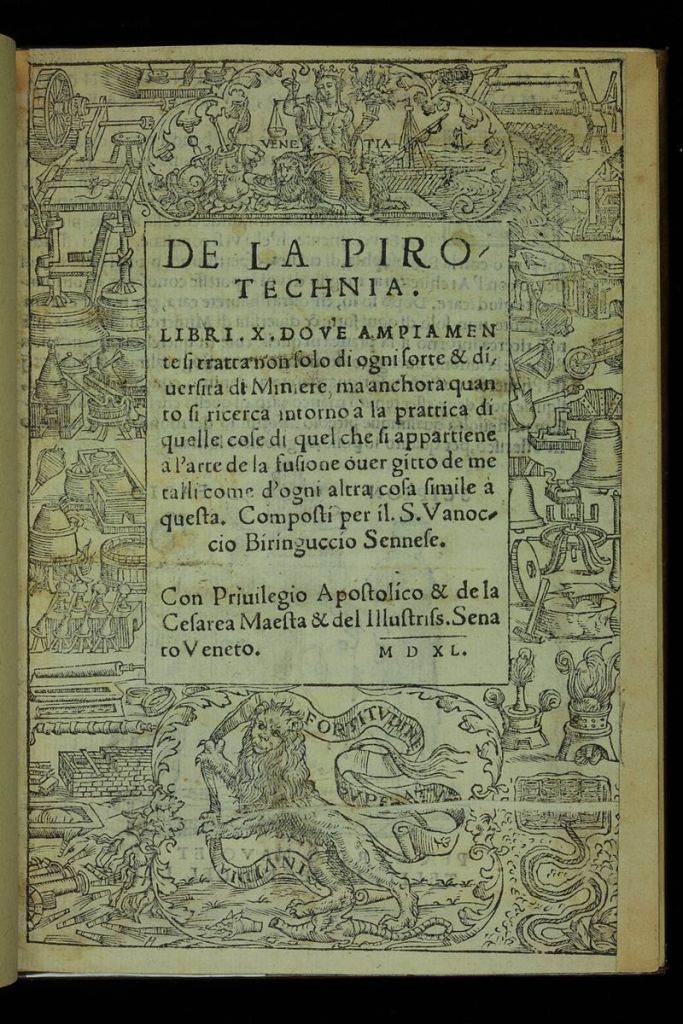
In Book I of De re metallica, Agricola deals with the industry of mining and ore smelting, moving on to finding minerals and metal ores in Book II. Book III discusses mineral veins and seams. After several books which discuss the smelting of various metal ores, the final Book XII, discusses salts, solvents, precipitates, and glass.
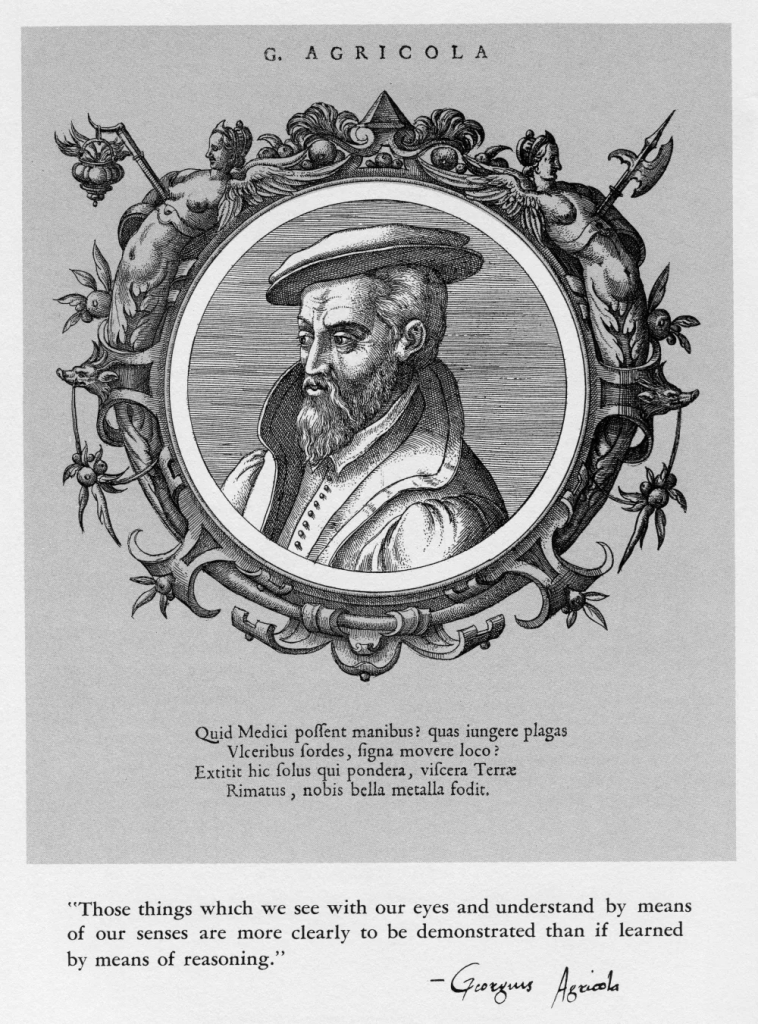
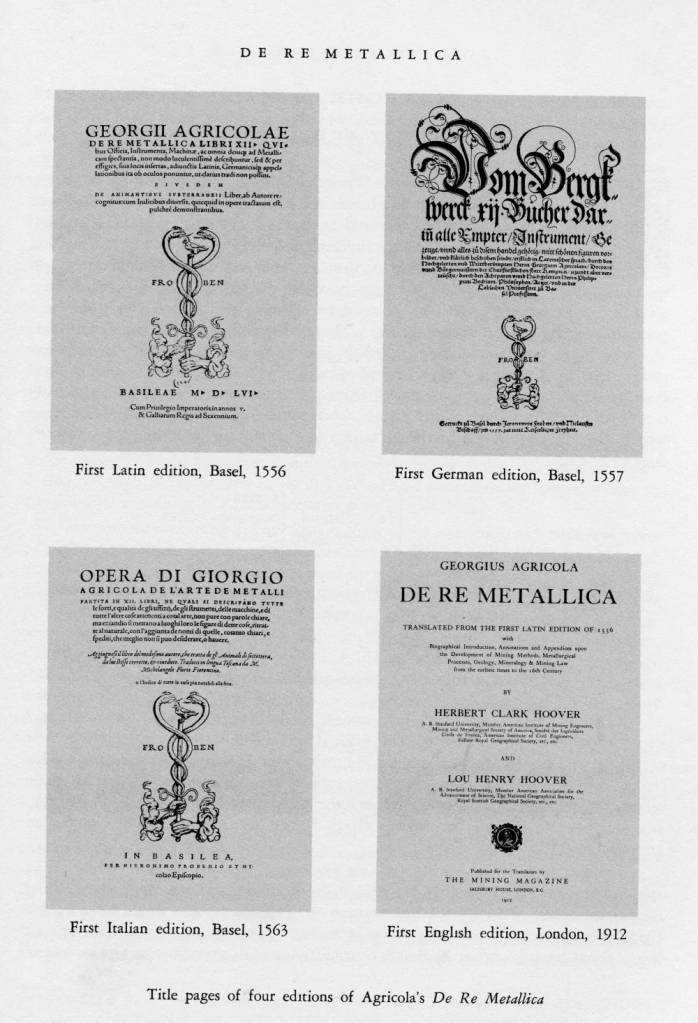
Unlike Biringuccio, who only discussed minerals in the context of his book on mining, Agricola wrote and published several other works on minerals. His earliest publication on mining Bermannus sive de re metallica dialogue (1530) also contained much on mineralogy, as did his De animantibus subterraneis (1549).
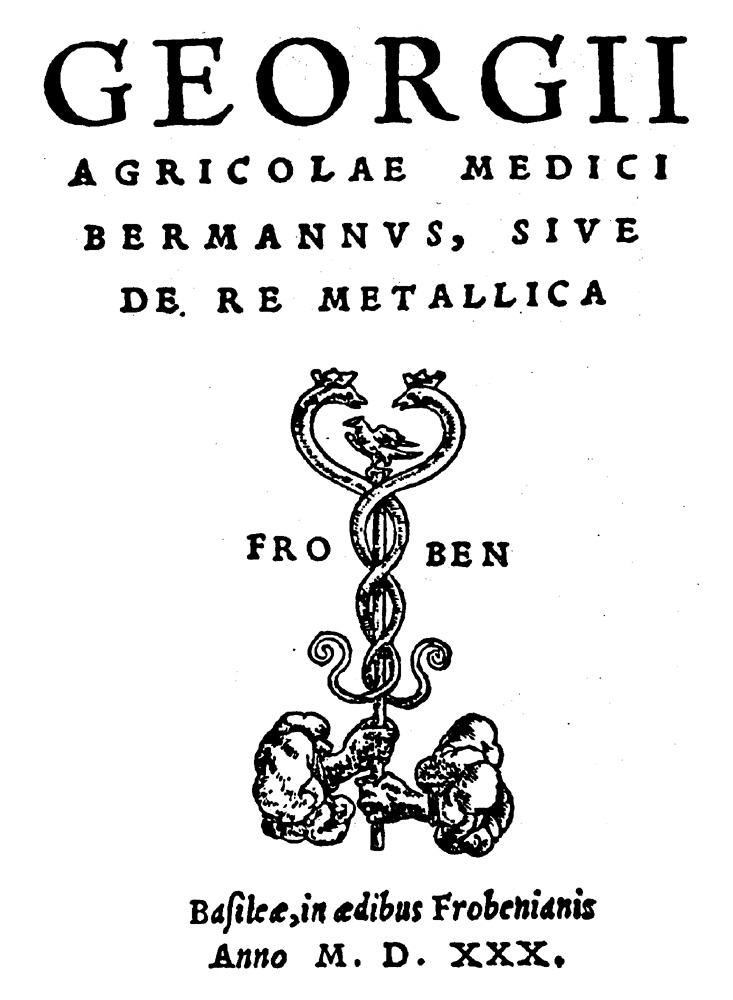
However, his major work was his De natura fossilium published in 1546; here the word fossil is used in the sense of things out of the earth. In the ten books of this work, he combined the extensive knowledge about fossils, minerals, and gemstones passed down from antiquity and the Middle Ages with the oral, vernacular, practical, traditional experience of the mineworkers, smelters, and stone masons about the occurrence, exploitation, appearance, structure, properties, and uses of those things found underground.
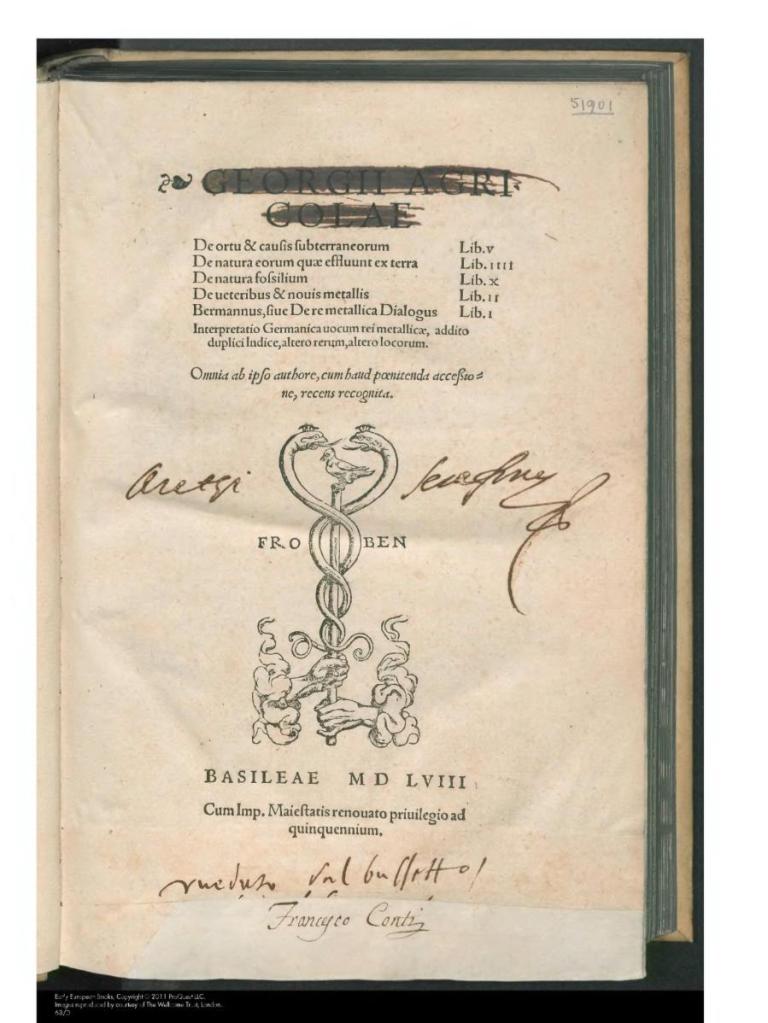
Anselmus de Boodt (1550–1632), who we met as the curator of the cabinet of curiosities of Rudolf II in Prague, was as a natural historian principally interested in cataloguing all know stones and mineral, a task to which he devoted a large part of his life.
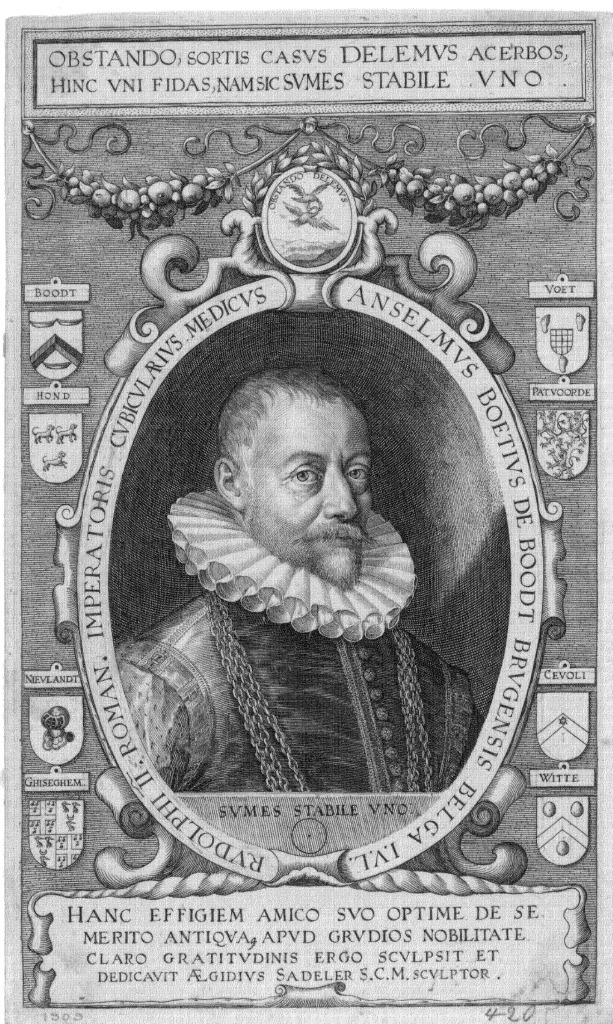
The results of his endeavours were published in Latin in his Gemmarum et Lapidum Historia (The History of Gems and Stones), the first edition, dedicated to Rudolf, appearing in Hanau in 1609. Two further editions appearing in Leiden in 1636 and 1647.
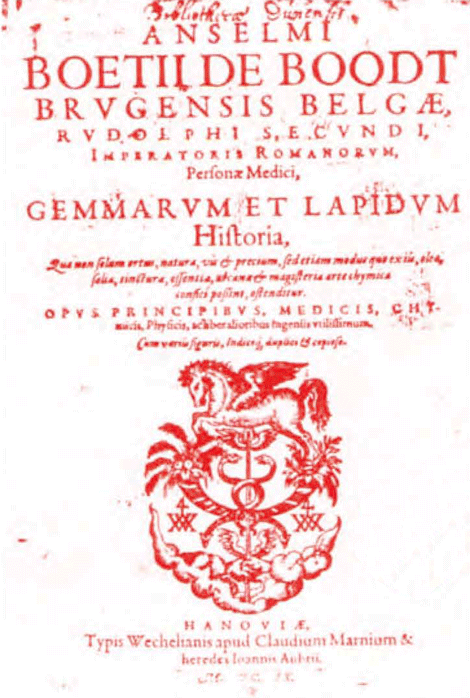
The third and final edition of 576 pages was in two parts. The first part gave the various causes of minerals, heavily influenced by the Work of Aristotle and Theophrastus but nevertheless giving providing unique accounts of how minerals are formed. The second part catalogues methodically hundreds of specific minerals, describing in detail their various identifying and curative properties.
Another specialist for minerals and fossils, who we met as curator of a cabinet of curiosities was Michele Mercati (1541–1593), who served the pope in this function as well as directing the Vatican botanical garden.
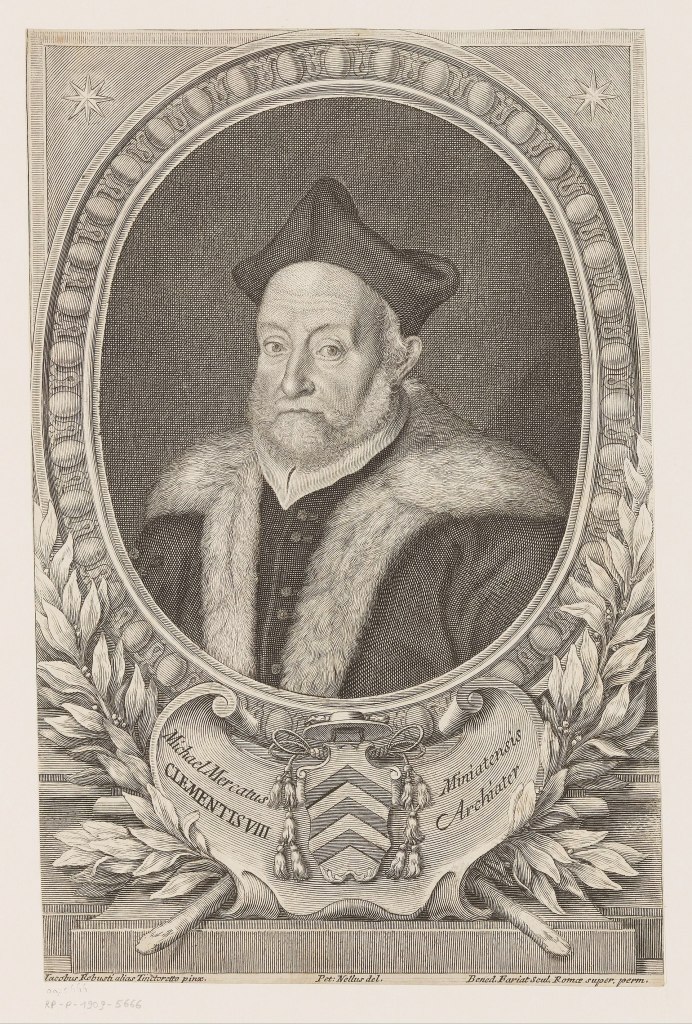
The emphasis of his collection lay in stones, minerals, and fossils. Based on his work, he wrote his Metallothica. Opus postumum, auctoritate et munificentia Clementis undecimi pontificis maximi e tenebris in lucem eductum; opera autem et studio Joannis Mariae Lancisii archiatri pontificii illustratum, which, however, was first published in Rome in 1717. Mercati was one of the first to recognise that the chipped flints in his collection were not, as believed at the time, produced by lightning but were tools produced by humans.
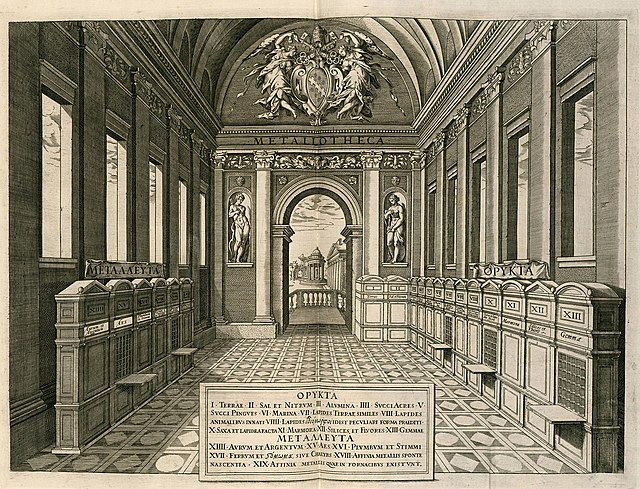
The sixteenth century’s perhaps greatest natural historian, Ulisse Aldrovandi (1522–1605), also had a very substantial collection of minerals, fossils, and stones in his teatro di natura (theatre of nature), and he of course wrote about them, although his text on the topic was one of those unpublished at the time of his death and the eventual late publication of his monumental Musæum Metallicum in 1648, certainly affected its reception, giving it not the attention it deserved. Already in his will in 1605, Aldrovandi was the first to use the word giologia (geology) in the modern sense, although his introduction had little impact, the usage first becoming widespread in the eighteenth century. Previously the word geologia had been used to distinguish earthly philosophy from theology.
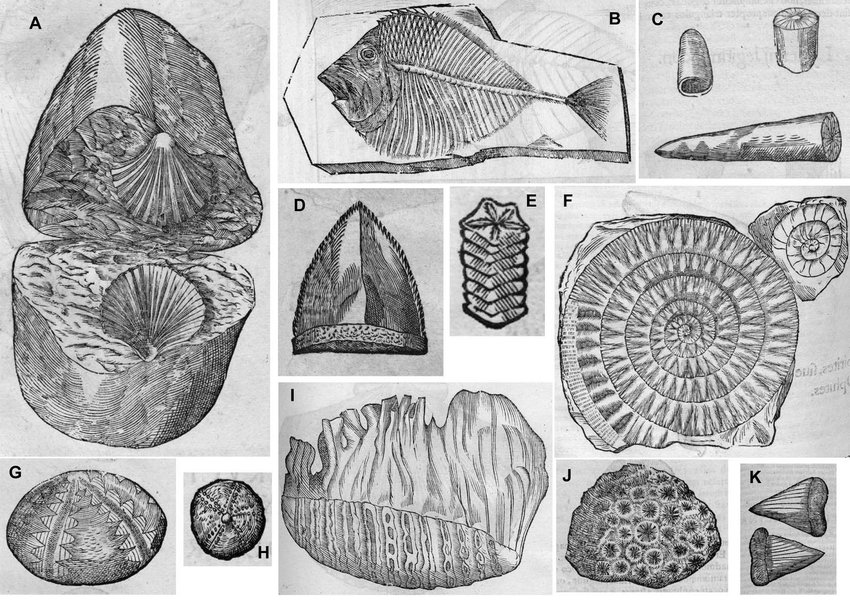
In his Musæum Metallicum, rather than simply listing the minerals etc, Aldrovandi attempts to apply a systematic classification to the objects under examination. He appears to be clearly aware of the organic original of fossils; Aristotle had claimed that fossils were stones that grew in the ground and only imitated organic forms. Aldrovandi was the first to recognise and describe microscopic fossils on the surface of a calcareous marble-like block: He almost certainly used a magnifying lens to do so. Aldrovandi’s work was in many senses highly innovative but had little impact, his various discoveries being remade by later researchers.
The other mega Renaissance natural historian, Conrad Gessner (1515–1565), also, as already noted above, also wrote and published a substantial work in the year of his death, his De Rerum Fossilium, Lapid um et Gemmarum maxime, figuris et similitudinibus Liber: non solum Medicis, sed omnibus rerum Naturae ac Philogiae studiosis, utilis et juncundus futurus, usually simple referred to as Fossils, Gems, and Stones. Although, he didn’t recognise the true origin of fossils, he did realise that their unusual appearance deserved recognition, and his book contains the earliest extensive collection of fossil illustrations.
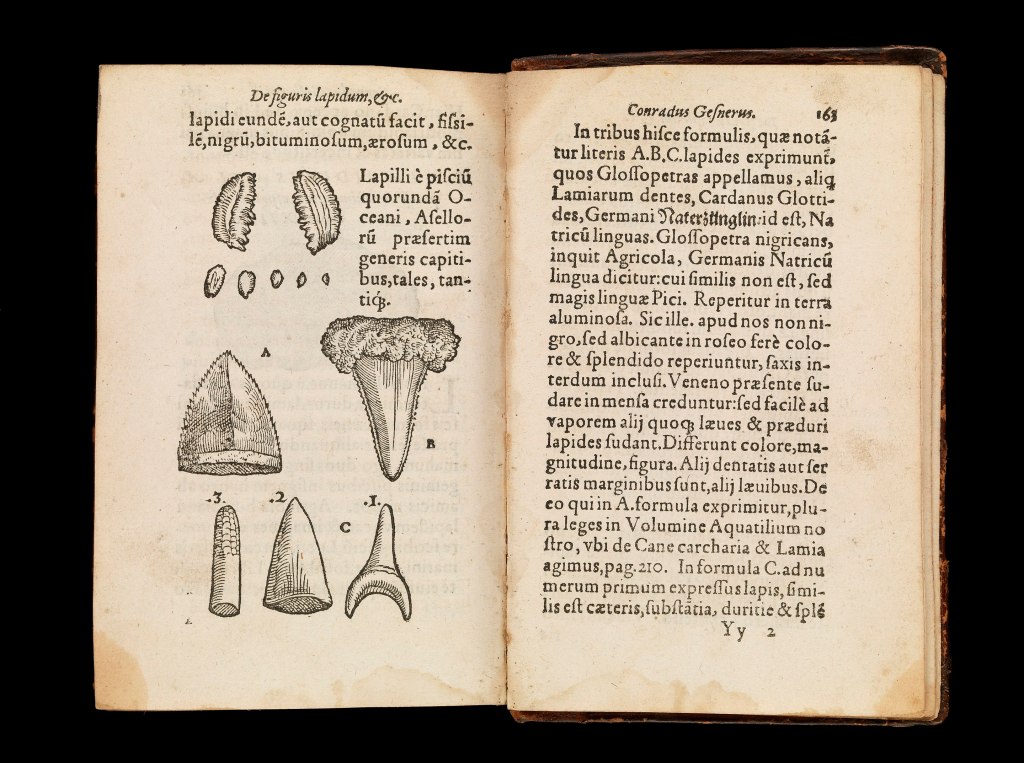
Gessner was not the first to published illustration of fossils, that honour goes to the German Lutheran rector Christoph Entzelt (1517–1583), who published a De Re Metallica: Hoc Est, De Origine, Varietate, & Natura Corporum Metallicorum, Lapidum, Gemmarum, atq[ue] aliarum, quae ex fodinis eruuntur, rerum, ad Medicinae usum deseruientium, Libri III, under the name Chistophorus Encelius, in 1557, which contains illustrations of four fossils. I have been unable to find out any more about Entzelt or his book.
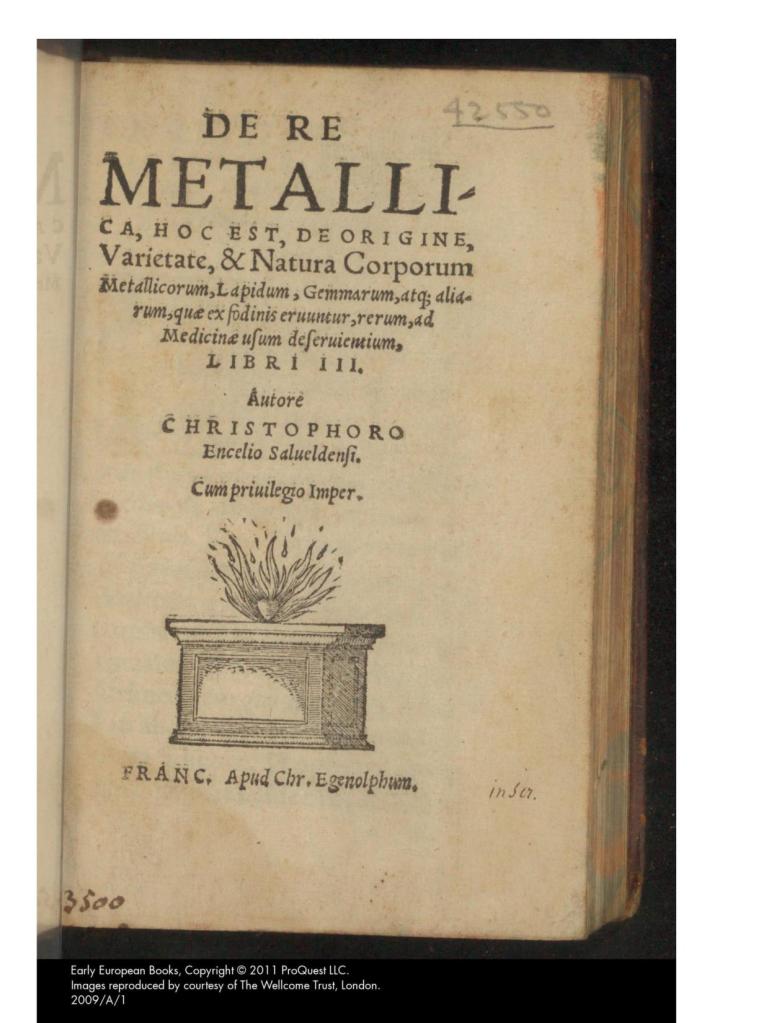
Like Aldrovandi, Gessner tried to systemise his presentation of the objects describe in his book by dividing them up into fifteen classes. However, his classifications were, by modern standards, trivial and or illogical and had very little influence on the developments within the disciplines of mineralogy, geology, or palaeontology.
In their books on the mining industry both Biringuccio and Agricola drew attention to stratigraphy, the layers under the surface of the earth playing a significant role in the practice of mining. Whilst discussing the types of layers that would potentially lead to fruitful seams of whatever was being mined in a given situation, they gave no thought as to how they various layers came into existence. The first scholar to do so was the Danish anatomist, palaeontologist, and geologist Niels Steensen (1638–1686), more generally known by the Latin version of his name as Steno.
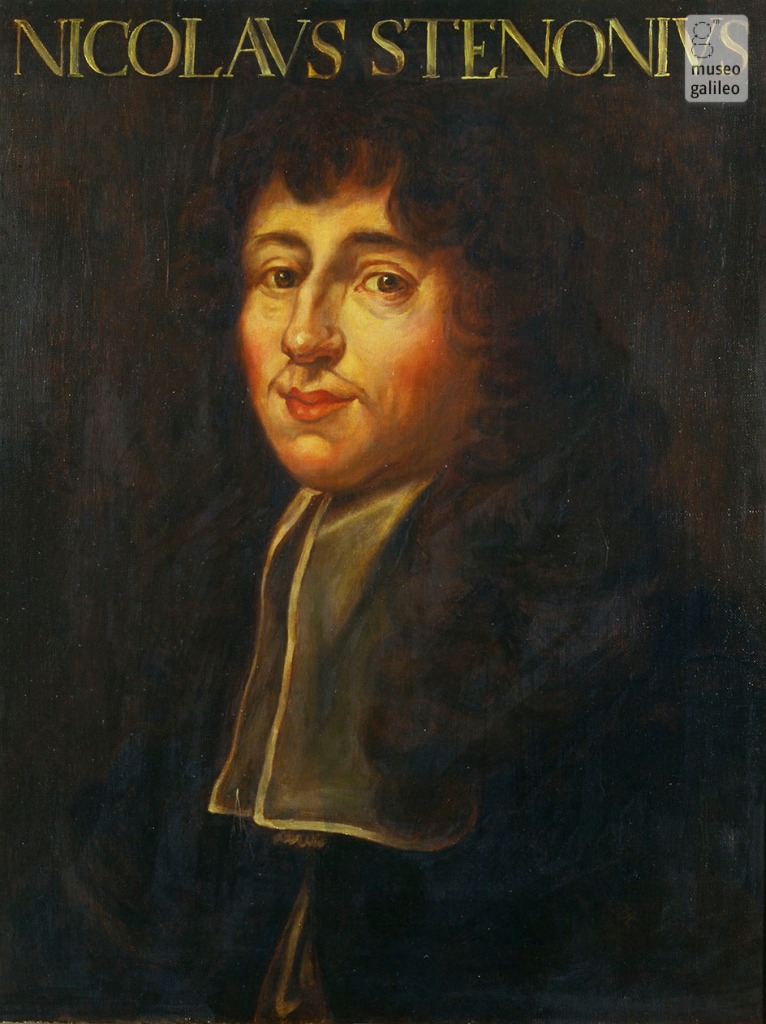
Born in Copenhagen, he studied medicine at Copenhagen University. After graduating he travelled first to Rostock and then on to Amsterdam and further to Leiden, where he studied anatomy together with Jan Swammerdam (1637–1680), Frederik Ruysch (1638–1731), Reinier de Graaf (1641–1673), and Franciscus de le Boe Sylvius (1614–1672). As an atomist he made important discoveries and contributions.
After travelling through France, he settled in Italy where he became a member of the Accademia del Cimento. Here, he first made a major contribution to palaeontology and then one to geology. In 1666, he dissected a female shark’s head and recognised the similarity between the shark’s teeth and the fossils known as glossopetrae or ‘tongue stones.’ Steno published his theories that fossils are organic material turned into stone in his Canis carchariae dissectum caput in 1667.
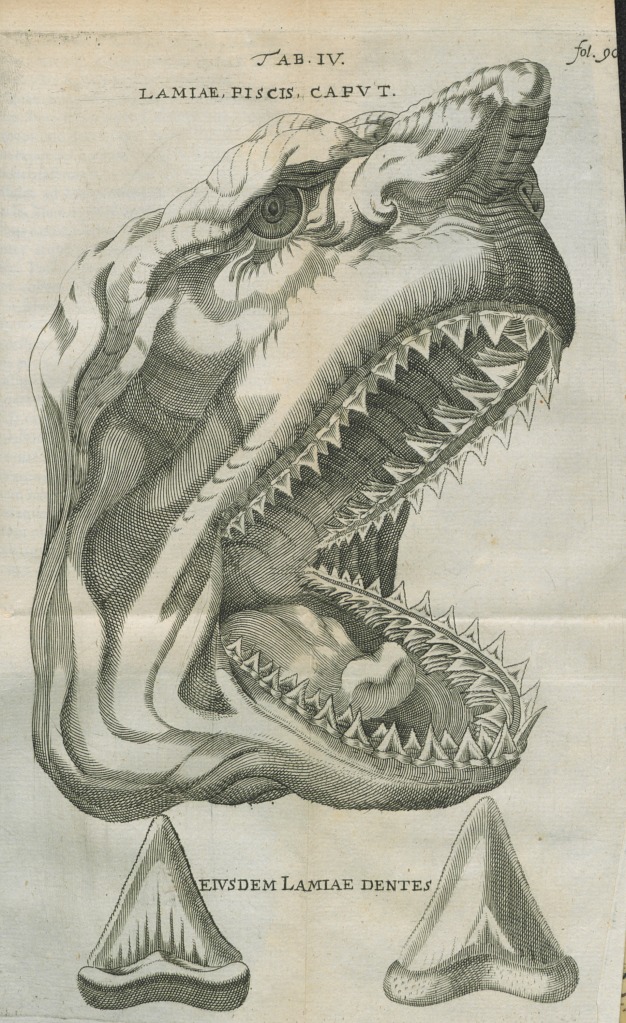
Previously, the Italian naturalist and botanist Fabio Colonna (1567–1640) had in his investigations found evidence that glossopetrae had organic origins, which he published in his De glossopetris dissertatio in 1616.
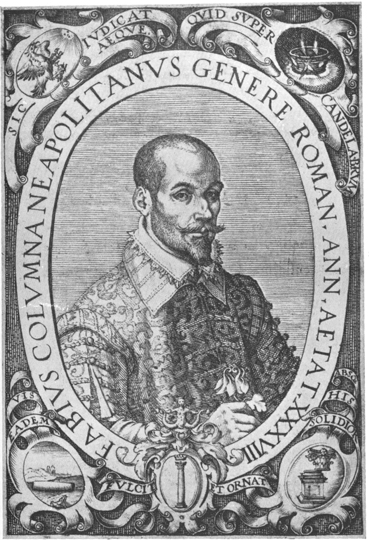
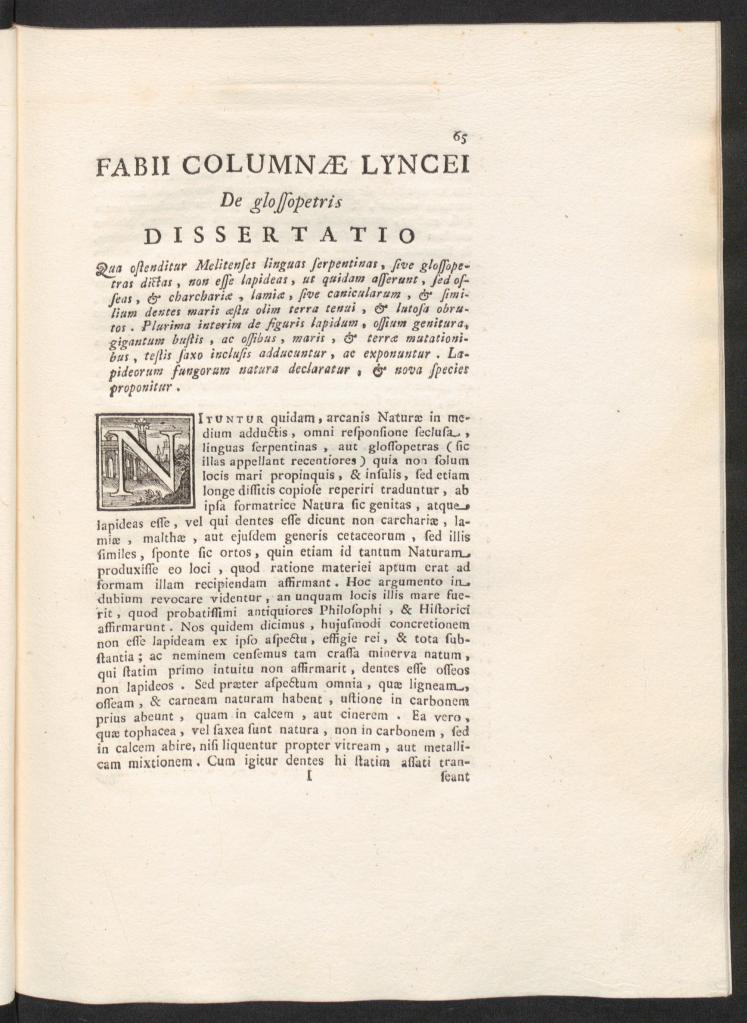
Whilst walking along the coast in Northern Italy Steno began to take interest in the exposed layers in the earth. He developed theories of stratigraphy defining four laws or principles of how the layers came into being, which he published in his De solido intra solidum naturaliter contento dissertationis prodromus (Preliminary discourse to a dissertation on a solid body naturally contained within a solid) in 1669.
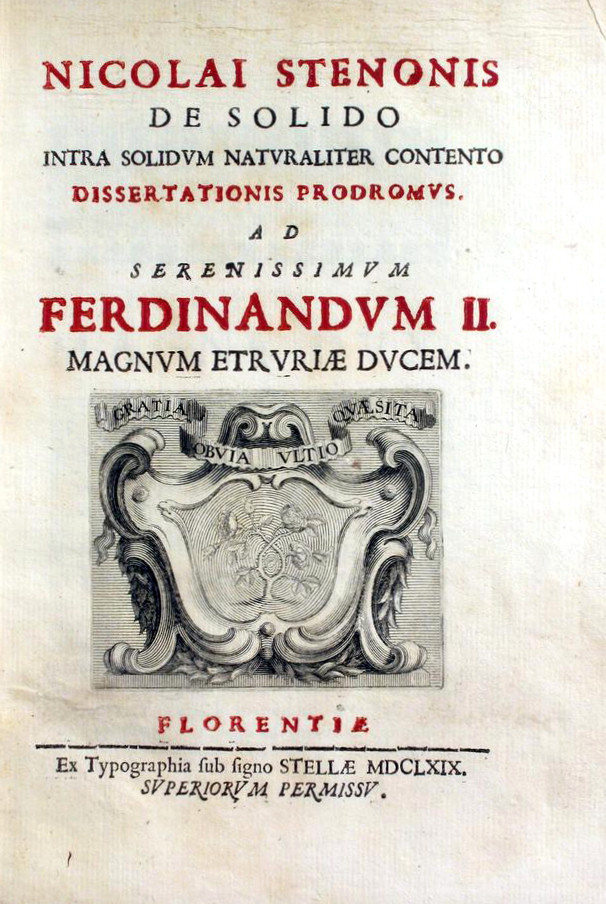
Steensen, in his Dissertationis prodromus of 1669 is credited with four of the defining principles of the science of stratigraphy. His words were:
- The law of superposition: “At the time when a given stratum was being formed, there was beneath it another substance which prevented the further descent of the comminuted matter and so at the time when the lowest stratum was being formed either another solid substance was beneath it, or if some fluid existed there, then it was not only of a different character from the upper fluid, but also heavier than the solid sediment of the upper fluid.”
- The principle of original horizontality: “At the time when one of the upper strata was being formed, the lower stratum had already gained the consistency of a solid.”
- The principle of lateral continuity: “At the time when any given stratum was being formed it was either encompassed on its sides by another solid substance, or it covered the entire spherical surface of the earth. Hence it follows that in whatever place the bared sides of the strata are seen, either a continuation of the same strata must be sought, or another solid substance must be found which kept the matter of the strata from dispersion.”
- The principle of cross-cutting relationships: “If a body or discontinuity cuts across a stratum, it must have formed after that stratum.”
(Taken from Wikipedia)
Somewhat bizarrely Steno converted from the Lutheran Protestantism of his birth to Catholicism in 1667. He was ordained a priest in 1675. He was consecrated bishop in 1677 and went off to Lutheran North Germany as a missionary. Living in poverty he died in 1686 after severe illness. In 1988 he was beatified by Pope John Paul II.

Although, the full development of palaeontology, geology, and minerology didn’t take place until the eighteenth century, during the Renaissance the first steps were taken in separating and defining the three as individual disciplines.